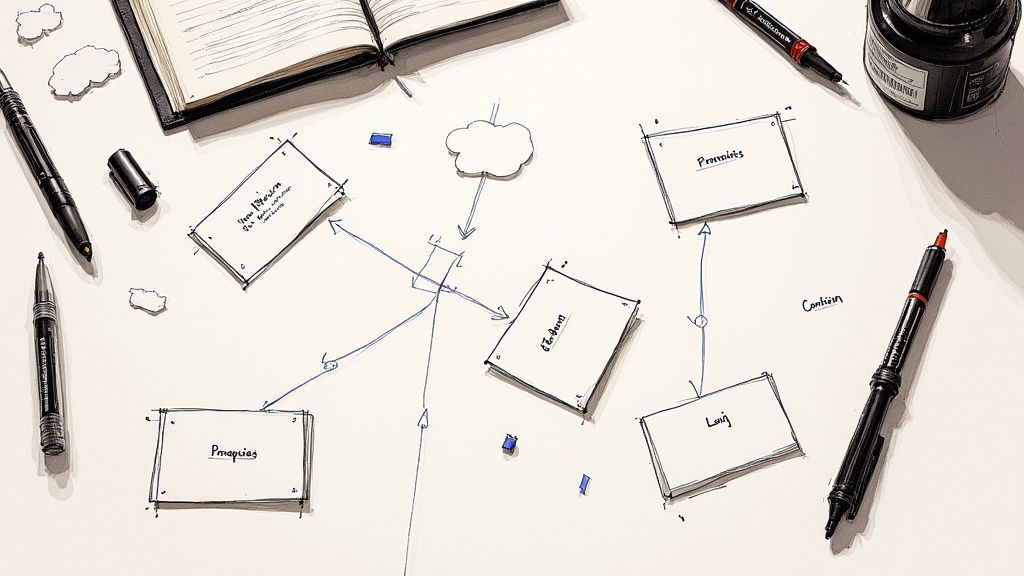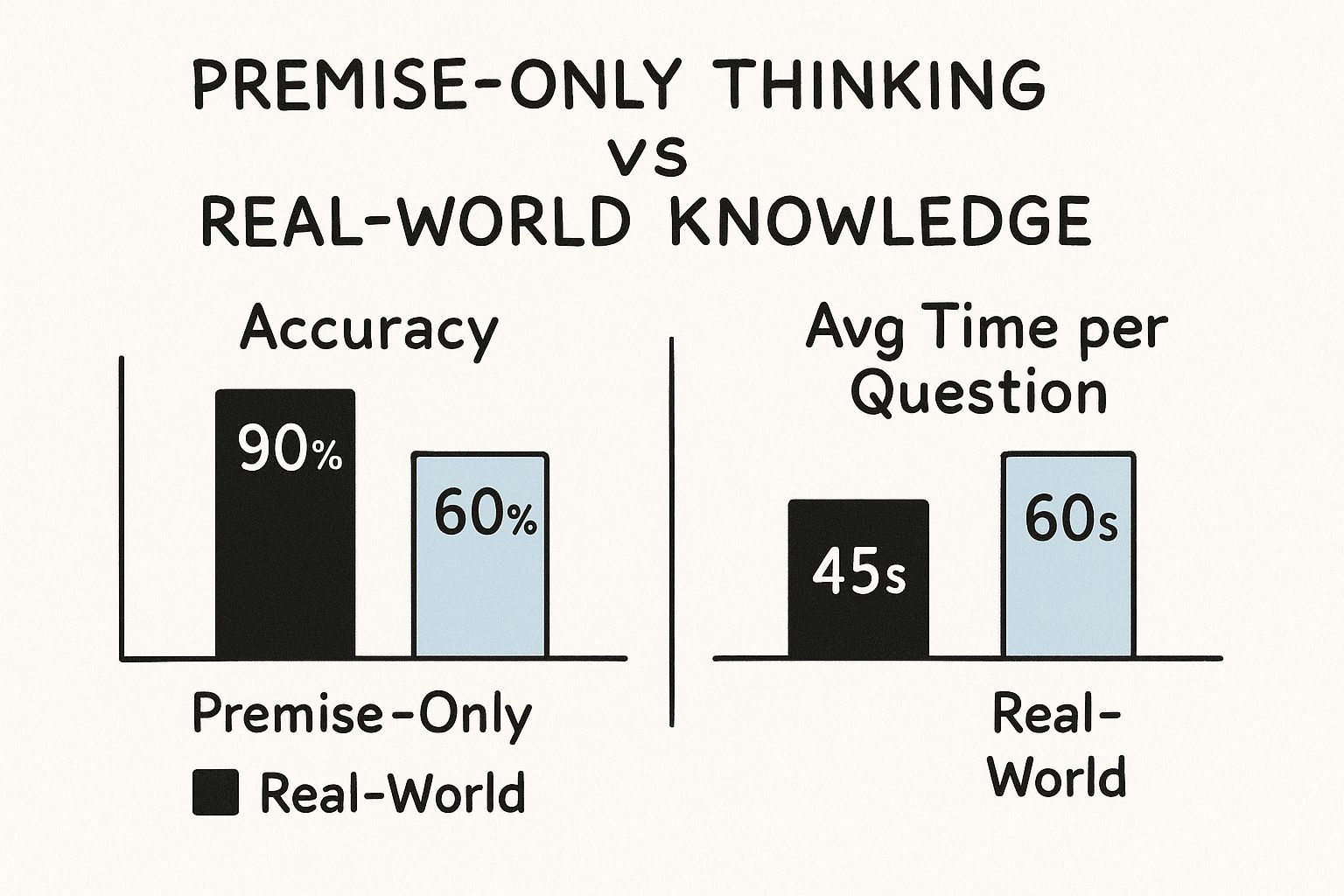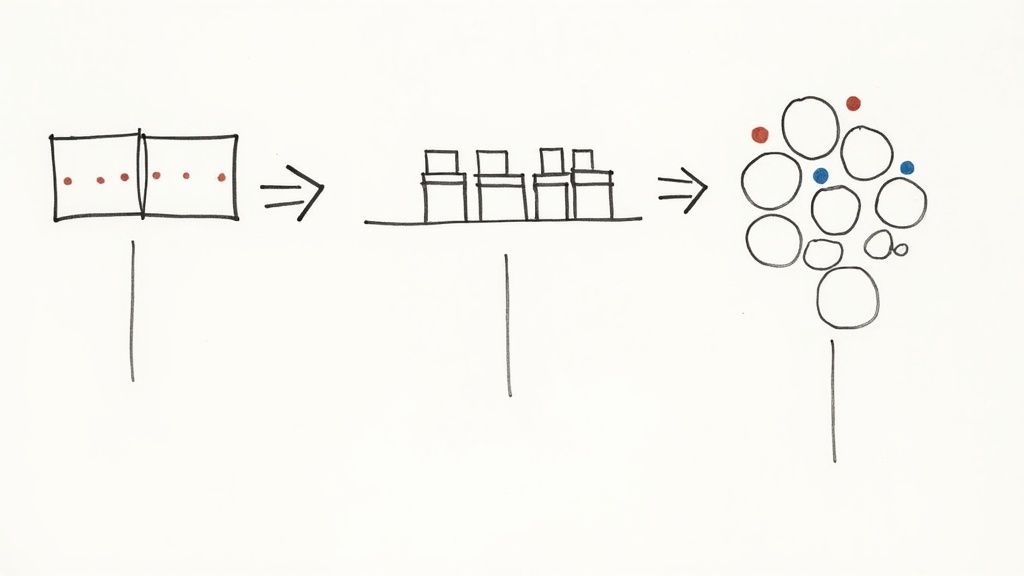Mastering the Deductive Reasoning Assessment Test

So, what exactly is a deductive reasoning assessment test? At its core, it’s a standardized way for employers to see how well a candidate can take a set of rules or general statements and arrive at a specific, guaranteed conclusion.
It’s less about what you already know and much more about how you think. This makes it a surprisingly powerful tool for predicting how someone might perform in a job that requires sharp, analytical thinking.
Understanding the Deductive Reasoning Test

The best way to think about a deductive reasoning test isn't as a typical exam, but more like a series of logic puzzles. Your job is to play the role of a detective. You're given a handful of clues (the premises) and you have to solve the case (reach the right conclusion) using only those clues.
What’s crucial here is that the test doesn't care about your real-world experience or personal opinions. It’s a pure test of your ability to follow a logical path from a broad statement down to a specific, certain outcome.
This kind of assessment has become a staple in many hiring processes, especially when companies are looking for people with top-notch problem-solving and critical thinking skills. It helps them spot candidates who can make solid judgments based on the data in front of them, follow complex instructions, and avoid jumping to conclusions.
What Is the Test Format
Deductive reasoning tests are a race against the clock, built to measure both how accurate you are and how fast you can work. Industry leaders like SHL have developed versions that are now used by major corporations worldwide.
A standard test usually contains 15-25 questions that need to be answered in a tight 10-20 minute window. This pressure-cooker environment forces you to process information quickly and efficiently.
This format is designed to see if a candidate can rapidly:
- Pinpoint the main rules or premises in a block of text.
- Connect the dots between different pieces of information.
- Decide which conclusion is the only one that can be true based on the information given.
Why This Skill Matters to Employers
Think about the modern workplace. Employees are constantly having to interpret company policies, follow detailed procedures, or sift through data to make smart decisions. A deductive reasoning test is just a miniature, focused version of those everyday challenges.
By testing this skill, employers get a good sense of a candidate's ability to tackle complex work with precision and consistency. It’s one piece of the puzzle, but it provides objective insight into a person’s cognitive horsepower. If you're curious about how these tests fit into the bigger picture, take a look at our guide on what psychometric assessments are.
Thinking Like the Test: Adopting a Logical Mindset
To really nail a deductive reasoning test, you have to get into a specific headspace. The secret is to completely buy into the test's internal logic, treating its rules as absolute truth—even when they sound completely bizarre.
Think of it like stepping into a video game. The game has its own physics and rules. If the game says characters can double-jump, you accept it. You don't argue that people can't do that in real life. That's exactly how you need to approach these tests.
Let's say a premise states, "All dogs are green." In our world, that's nonsense. But for that one question, inside the test's little universe, it’s a non-negotiable fact. Your entire job is to work only within that constructed reality and ignore everything you know to be true outside of it.
Why Premise-Only Thinking Is Your Superpower
The single most effective tool you can bring to this test is the ability to separate its rules from your own life experience. Every question is its own self-contained puzzle with a unique set of rules. You just have to figure out what conclusions are guaranteed by that puzzle's design.
This takes some serious mental discipline. It means actively shutting out the real-world knowledge and logical shortcuts we all use every single day.
For example, if a premise says, "All managers work from the office," and another says, "Sam is a manager," then the only possible conclusion is that "Sam works from the office." It doesn't matter what you know about remote work or hybrid schedules. Those real-world facts are irrelevant.
The infographic below really drives this point home, showing the stark difference in performance when you stick to the premises versus letting outside knowledge creep in.

Internal data from multiple assessment providers shows a clear trend: test-takers who rigorously apply only the given premises often see accuracy improvements of up to 30% and complete tests faster. It's not about being smarter; it's about applying the right strategy. This kind of structured thinking is a skill, and like any skill, it gets better with practice.
If you're looking to build this kind of analytical muscle, methods like Problem-Based Learning are fantastic for sharpening the exact critical thinking skills these tests are designed to measure.
Sidestepping the Common Logical Traps
Once you adopt this mindset, you'll naturally start to sidestep the most common mistakes people make. Test creators deliberately lay traps to catch anyone who makes assumptions or jumps to conclusions that seem likely but aren't guaranteed.
Here are a few classic pitfalls this mindset helps you dodge:
- Making Unwarranted Assumptions: You can't fill in the blanks with information that wasn't explicitly given to you in the premises.
- Applying General Knowledge: You have to resist the urge to use real-world facts to supplement or contradict the test's rules.
- Confusing 'Possible' with 'Certain': The correct answer isn't something that could be true; it's the one thing that must be true.
By treating each question as a self-contained world with its own unbreakable laws, you effectively neutralize these traps. This allows you to answer with precision and confidence, which is the fundamental shift that separates the top-scorers from everyone else.
2. A Look at Common Question Types (With Examples)

A deductive reasoning test isn't just a random assortment of brain teasers. The questions follow specific, predictable formats, each designed to probe your logical skills from a different angle.
Getting comfortable with these core question types is the first real step toward acing the test. Most assessments boil down to three main formats: syllogisms, arrangements, and grouping questions. Once you can spot them, you can jump straight to the right problem-solving strategy without missing a beat.
Let's unpack each one.
Syllogisms: The Classic Logic Puzzle
Syllogisms are the bread and butter of deductive reasoning. You're given two or more statements (called premises) and asked to find the only logical conclusion that absolutely must be true based on them.
The trick is to treat the premises as undeniable facts and connect them to form a logical chain. Think of it like a domino rally—the first statement knocks over the second, leading to a single, inevitable result.
Example Syllogism:
- Premise 1: All project managers must attend the weekly sync.
- Premise 2: Sarah is a project manager.
- Conclusion: Therefore, Sarah must attend the weekly sync.
This is the only conclusion guaranteed by the information. Anything else, like "Sarah enjoys the weekly sync," would be a pure assumption, and that's exactly what these questions test you to avoid.
Arrangements: Putting Things in Order
Arrangement questions are all about spatial or sequential logic. They give you a set of rules and ask you to organize people or items correctly based on those constraints. Think of creating a seating chart, scheduling events in order, or ranking team performance.
These questions really test your ability to visualize relationships and juggle multiple conditions at once. The best shortcut? Don't try to solve it in your head. A quick sketch or a simple table is your best friend here.
Example Arrangement:
- Rules: Five people (Ali, Ben, Chloe, Dan, Eva) are in a line. Ben is directly behind Ali. Chloe is somewhere ahead of Dan. Eva is at the very front of the line.
- Question: Which of the following arrangements is possible?
- Strategy: Start with the certainties—lock Eva into the front spot. From there, you can use the other rules to eliminate the impossible options and zero in on the one valid sequence.
Grouping: Sorting by Common Ground
Grouping questions test your ability to categorize things based on a given set of conditions. You’ll get a list of items and rules about how they can (or can't) be put together, and your job is to figure out which combinations work.
This is a direct measure of your skill in applying rules consistently across a dataset. It's a key component in many assessments that gauge analytical thinking. If you're curious, you can see how this fits into the bigger picture by exploring some common examples of psychometric tests.
The real challenge with grouping questions is keeping track of who or what fits into which category without breaking any rules. This skill is a direct parallel to real-world tasks like assigning people to project teams based on their skills or allocating resources where they fit best.
To give you a bird's-eye view, here’s a quick summary of what to expect from each question type.
Deductive Reasoning Question Types at a Glance
| Question Type | What It Measures | Top Tip |
|---|---|---|
| Syllogisms | Your ability to draw a guaranteed conclusion from given premises. | Accept the premises as 100% true, even if they seem strange. Focus only on what must follow. |
| Arrangements | Your ability to organize items spatially or sequentially based on a set of rules. | Draw a diagram. Don't try to manage all the moving parts in your head. |
| Grouping | Your ability to categorize items into groups according to specific conditions. | Create a checklist or table to track which items satisfy which rules. |
Getting a feel for these three formats is half the battle. When you know what you’re looking at, you can stop feeling overwhelmed and start developing a clear plan of attack.
How Test Scores Predict Real-World Job Success
It’s easy to look at a deductive reasoning test and see it as just another abstract hurdle in the hiring process. But top companies don't use these assessments just for the sake of it. There's a clear, evidence-backed connection between how someone performs on these tests and the skills they'll need to succeed in complex, high-stakes jobs.
Scoring well isn't about being good at puzzles; it's a direct signal of core cognitive abilities. A high score tells an employer that a candidate can absorb rules, pinpoint critical information, and draw logical conclusions under pressure. These are the exact skills someone in law, finance, tech, or consulting uses every single day.
From Test Logic to Job Competencies
The connection becomes crystal clear when you break down what the test is actually measuring. When someone successfully works through a deductive reasoning problem, they're mirroring the thought process required for key on-the-job competencies.
High scorers almost always show a strong knack for:
- Strategic Thinking: They can see how different pieces of a puzzle fit together to form the bigger picture, which is essential for planning and executing complex projects.
- Data Analysis: They have a talent for cutting through the noise, focusing only on the data that matters, and pulling accurate insights from it.
- Rule-Based Decision-Making: They possess the discipline to work within established rules—be it company policy, legal statutes, or technical specs—without making risky leaps of faith.
These aren't just "nice-to-have" traits; they are the bedrock of strong job performance. Think about it: an employee who can correctly interpret a dense company policy is far less likely to make a costly compliance mistake. In the same way, a software developer who can logically trace a bug through thousands of lines of code will solve problems faster and more effectively. The mental muscle being flexed is the exact same one used in the test. To dig deeper into this, it helps to understand the core principles of validity and assessment in hiring.
The Data-Backed Link to Performance
This link between test scores and job success isn’t just a theory; it’s backed by real, measurable outcomes. In the world of pre-employment screening, these tests have proven to have significant predictive validity.
Research has repeatedly demonstrated that cognitive ability tests, including deductive reasoning assessments, are strong predictors of job performance. A landmark meta-analysis by Schmidt and Hunter (1998) found that general cognitive ability was the single best predictor of job performance across a wide variety of roles, with a validity coefficient of .51. This suggests that candidates who score higher are significantly more likely to succeed in their roles, particularly those requiring complex problem-solving.
This data brings us to a crucial takeaway: your test score is much more than a number. It’s a reliable preview of your ability to handle ambiguity, stick to complex guidelines, and make sound, evidence-based decisions when it truly counts.
Ultimately, a deductive reasoning assessment test gives employers a standardized, objective look under the hood at a candidate's problem-solving engine. When you understand this connection, your mindset shifts. You're no longer just trying to pass a test; you're demonstrating a fundamental skill set that proves you have what it takes to thrive in a challenging career.
Proven Strategies to Improve Your Speed and Accuracy

Doing well on a deductive reasoning assessment test isn't just about knowing the rules of logic. It’s about applying them—quickly and correctly—when the clock is ticking. The good news is that you can absolutely get better with the right approach. It really boils down to having a game plan for managing time, visualizing the problem, and sidestepping common mistakes.
These tests are built to be tough, and the tight deadlines are part of the challenge. They reward people who can think efficiently. The trick is to have a few go-to techniques in your back pocket so you can tackle the problems proactively, not just react to them.
Master the Clock with Smart Time Management
With maybe a minute or two per question, you can't afford to get bogged down. The first thing you need to do is find a good pace. If you hit a wall on a particularly tricky question, don't let it sink your whole performance. It’s much smarter to take your best guess and move on than to burn precious minutes on a single problem.
The only way to build this discipline is to practice. Set a timer when you work through sample questions to get a feel for the real thing. This helps you develop an internal sense of timing, so you'll know instinctively when it's time to cut your losses and bank points on the next question.
Visualize Complex Problems
For those tricky scheduling or arrangement puzzles, trying to juggle all the pieces in your head is a recipe for disaster. The single best thing you can do is get it all out of your head and onto paper (or a digital scratchpad).
A simple diagram, a quick table, or a little flowchart can make an abstract puzzle feel much more concrete. For instance, if you're asked to arrange five people in a line based on a set of conditions, just draw five blank spaces. As you read each rule, start filling in the slots. It’s a world of difference from trying to manage it all mentally.
This method does a few key things for you:
- Keeps track of certainties: You can lock in the information you know for sure.
- Spots contradictions: It becomes obvious when a certain arrangement breaks one of the rules.
- Tests possibilities: You can work through different scenarios one by one without losing your place.
By offloading the mental work, you free up your brain to focus on what really matters: solving the logic.
Avoid Common Candidate Mistakes
Many smart people stumble over the same predictable hurdles. Once you know what they are, they’re surprisingly easy to avoid. Think of it as a crucial part of your prep—learning what not to do.
The biggest mistake by far is bringing in outside knowledge. You have to remember that the test exists in its own little world. If a premise says "all fish can walk," you must accept it as a 100% true fact for that specific question.
Here are the top three blunders to watch out for:
- Overthinking the Question: These problems are designed to be solved with the information given. Don't go searching for hidden meanings or trying to read between the lines. Just stick to what's on the page.
- Making Assumptions: Never fill in the blanks with what seems likely or logical in the real world. A conclusion is only valid if it must be true based on the premises, with no room for doubt.
- Ignoring Negative Keywords: Little words like "not," "never," or "except" can completely flip the meaning of a statement. A moment of careless reading can lead you to the exact wrong answer.
When you combine sharp time management, a willingness to visualize problems, and an awareness of these common errors, you create a powerful strategy. It's an approach that will help you tackle any deductive reasoning test with confidence and improve your score.
How to Use Deductive Tests for Smarter Hiring
For any hiring manager, a deductive reasoning assessment isn't just another screening tool. Think of it as your secret weapon for pinpointing candidates who possess serious analytical horsepower.
When you use these tests the right way, they give you hard data that cuts through the noise of subjective bias. Suddenly, your hiring decisions shift from gut feelings to genuine evidence. The best time to deploy them is early in the process, letting you filter for core problem-solving abilities before you even think about scheduling interviews.
But here's a crucial piece of advice: a test score is just one piece of a much larger puzzle. It's not the whole story. You have to look at the results alongside a candidate's resume, their interview performance, and any work samples they provide. This gives you a complete, well-rounded picture of who they are.
For a deeper dive into creating a comprehensive evaluation system, our guide on pre-employment assessment tools is a great resource.
Making this work means committing to a fair and positive experience for every applicant. Always partner with validated, reliable assessment platforms. This not only respects your candidates' time but also gives you legally sound insights for your hiring process. By thoughtfully weaving deductive tests into your approach, you're not just filling a role; you're building a stronger, more capable team ready to tackle complex challenges with logic and precision—a core part of any winning talent strategy.
Your Questions, Answered
It's natural for both recruiters and candidates to have questions about deductive reasoning tests. After all, they're not your everyday quiz. Let's clear up some of the most common ones.
How Can I Prepare for a Deductive Reasoning Test?
The best way to get ready isn't about cramming information. It's about sharpening a specific mental muscle.
The most effective strategy is to work through lots of timed sample questions. This gets you comfortable with the different question styles you'll encounter, like syllogisms or seating arrangements, and helps you pick up your pace. Your goal is to train your brain to focus only on the information given in the problem, completely ignoring any outside knowledge you have. Practice that one skill, and you'll see your performance improve.
Are These Tests Actually Fair?
This is a big one, and the answer is yes—when they're built properly. In fact, a well-designed cognitive test is one of the fairest hiring tools out there. A friendly chat in an interview can easily be swayed by unconscious bias, but a deductive reasoning assessment test is different. It’s standardized.
Every single candidate faces the exact same logical puzzles and is measured against the same objective standard. Research has consistently shown that these kinds of structured assessments are excellent predictors of on-the-job performance and lead to more equitable hiring.
The key for employers is to stick with professionally validated tests from trusted providers. This ensures the assessment is fair, reliable, and legally sound.
What Does a Low Score Really Mean?
A low score is not a judgment on a person's intelligence or overall ability. It simply suggests that their natural cognitive strengths might be in areas other than pure, rule-based deduction.
Remember, deductive reasoning is just one piece of the puzzle. A candidate might be an incredible creative thinker who excels at spotting patterns (that's inductive reasoning) or a fantastic communicator. These tests don't measure those skills. That’s why it’s so important for companies to view test results as just one data point among many. A score reveals a person's preferred thinking style, not their total potential.
Ready to build a stronger, more logically adept team? MyCulture.ai offers customizable assessments to help you identify top analytical talent with confidence. Discover how our science-backed platform can help you make smarter, data-driven hiring decisions today.